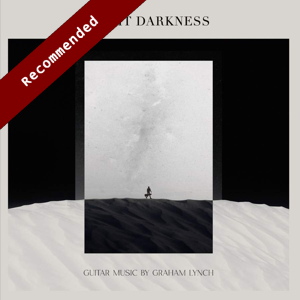
Graham Lynch (b. 1957)
Light Darkness
Figures from Watteau for guitar duo (2018)
Dark Sonata for guitar duo (2020)
Naïvement-Rondeau for guitar trio (2018)
Waltz Cocteau for guitar quartet (2018)
Serenata Notturna for five guitars (2021)
Pájaros del Mar for guitar duo (2005)
Rody van Gemert, José Casallas, Mari Mäntylä, Petri Kumela, Antti Ignatius (guitars)
rec. 2021, Roihuvuori Church Helsinki, Finland
Pilfink Records JJVCD252 [52]
The idea behind this programme is to let the guitarists explore the intermingling of dream, darkness and light. Graham Lynch, influenced by several composers and artists of the past, created music subject to rapid mood changes, great fluidity of time and considerable variety. The album majors on time, characters and places, and on wide-ranging emotions. All the works have a strong sense of chiaroscuro that can be a central characteristic of the guitar. It may help to be aware of Lynch’s highly eclectic style, which ranges from tango and neo-baroque, by way of serialism to post-modern Romanticism. (For more on the composer, see his webpage.)
Figures from Watteau for guitar duo is a charming piece that takes its cue from the paintings of Jean-Antoine Watteau (1684-1721). Known best for his bucolic and idyllic paintings, he also produced several canvases of the Commedia dell’arte and the ballet (they show fifteen stock characters, including Pierrot, Harlequin, Flamina, Scaramouche and Sylvia). The slow first number reflects Pierrot Content. This magical painting shows the sad clown at peace in a garden with three companions: the lady on his right is playing the lute. Almost hidden in the dark background is a statue of the god Pan. But does the tranquillity of this music hide some pain? The second number, The Italian Comedians, is a hurly burly of wit and the unruly. Watteau’s characters seem to have just given a performance. Yet even here, there is melancholy: all is not knockabout.
The large three-movement work on this disc, Dark Sonata for guitar duo, may have been completed during lockdown. It was composed for the Helsinki Guitar Duo. The first movement, In Shadows, is will o’ the wisp, with its mosaic of sections, timbres and colours. Lynch suggests a Midsummer Night’s Dream quality in these pages. The second movement, dance-like and rhythmically pliable, is less dark and more good-natured than may be expected; there is a lyrical middle section. The finale justifies its title: Night is like entering a dense forest, in physical reality or in the mind. It is unsettling, with some dissonance, little illumination, and it concludes with intensely frigid chords.
The Naïvement-Rondeau for guitar trio was inspired by the music of François Couperin, the writings of Denis Diderot and the paintings of Watteau. Lynch points out that naïvement is meant as natural or innocent, nor naïve. The feeling is deeper and more thoughtful than the title may indicate. The episodes in the rondeau are dramatic and even disquieting.
Jean Cocteau, one of the outstanding polymaths of the 20th century, was a film director, poet, novelist, painter, playwright, set designer and actor – and a leading light in the avant-garde movement. Waltz Cocteau for guitar quartet matches the author’s “characteristic spirit and temperament, demonstrating a lightness of touch, with twists and turns, together with elements of surprise and illusion”. I felt a shadow of Poulenc over this enchanting work.
The Serenata Notturna for five guitars owes its inspiration to Mozart’s piece by the same title. (Lynch first wrote it for the guitar orchestra of the Avonia Institute in Finland.) It follows the Salzburg master’s order of movements, only substituting a Waltz for the Minuetto. According to the liner notes, the piece has a pedagogical aspect: the Institute requested “each movement to explore specific intervals”, giving the young players the opportunity to have “an element of ear training”. Lynch does introduce a variety of intervallic interest harmonically and melodically. The March is cool, sometimes lugubrious and never militaristic. The Waltz is definitely nocturnal, quite lovely in the delicious study of its harmonic material but balanced by a slightly more animated trio section. Excitement is the keynote of the concluding Rondo. There is a Spanish feel here – or is it Celtic? Despite the above-mentioned “learning curve”, there is nothing pedantic about this piece.
Pájaros del Mar (sea birds) for guitar duo was originally scored for flute and cello. This arrangement ticks all the boxes, giving a stunning evocation of the work’s subject matter. Lynch resides in Cornwall, but this music is also full of Iberian tropes. This is not birdsong, such as Messiaen may have imagined. This mood music describes, for me, the Atlantic Ocean and the Mediterranean Sea. Sunlight and splashing waters balance introspective, more nocturnal moments. It only lasts just over five minutes; I want it to go on for ever.
The booklet leaves a lot to be desired. The notes are fine, although a little more analysis could have been included for each piece. What I struggle with is the “artistic” design, which makes reading the notes a struggle; tiny white print on a shiny black background is never easy on the eyes; photographs of the performers are indistinct; and even the sleeve cover lacks inspiration. But the performances, the recording and the music are superlative.
I enjoyed every note of this beautiful programme. It is truly an exploration of light and darkness, and the music is evocative, immediately approachable and ultimately satisfying.
John France
Help us financially by purchasing from



















